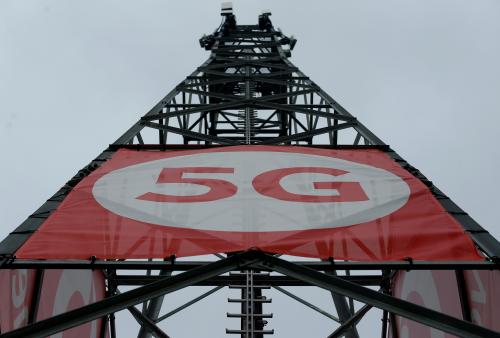Tom Wheeler served as the 31st Chairman of the Federal Communications Commission from 2013-2017.
For decades we have heard of the “spectrum shortage.” The growth in wireless usage—from Wi-Fi to smartphones and tablets—was taxing the finite supply of the airwaves that carry those services. Spectrum seemed to be a modern example of an observation attributed to Mark Twain about investing in land because “They’re not making it anymore.”
Like land, spectrum has been a rivalrous asset in that if one party owns it, another party cannot. Digital technology has changed that equation, however, to allow for multiple users to share the same piece of spectrum without causing signal interference. Such sharing could possibly put a serious dent into—or even eliminate—the “spectrum shortage.”
Now, the largest user of spectrum, the Department of Defense (DoD), has put out a Request for Information (RFI) that seems to propose that at least some of the spectrum traditionally used by the military could be shared for a fifth generation (5G) wireless network. The DoD cites a component of 5G technology called dynamic spectrum sharing (DSS) as the vehicle to accomplish this.
The DoD concept for spectrum sharing is the simple application of digital electronics. Such sharing is a good idea as 5G networks put even more pressure on the need for spectrum. A not-so-good-idea, however, has been suggested by the Trump campaign: that the shared spectrum would be used by the federal government to build and operate a 5G network.
How Spectrum Sharing Works
During the Obama years, the Federal Communications Commission (FCC) negotiated with the Defense Department to create a shared band of spectrum that could be used both by the military (principally the Navy) as well as those who wanted to deliver both commercial and unlicensed wireless service. How spectrum sharing works is exemplified by the Wi-Fi in our homes in which we use the same piece of unlicensed spectrum as our neighbors without interfering with each other. The neighbors are non-rivalrous users because each can use the same piece of spectrum without limiting anyone else.
Wi-Fi works because it is a “listen before talk” technology. That means that before it sends out a packet of data, the Wi-Fi device “listens” to see if another device is transmitting. Because it is digital, that “listening” is measured in milliseconds. If the neighbor is transmitting, your Wi-Fi device will wait until there is an open millisecond-sized slot before shoving some of your data into that unused space.
The beauty of digital signals is that they can be more flexibly shared than the old analog signals. Consider, for instance, over-the-air television. Prior to 2009, American TV broadcast signals were transmitted in analog format (think LP recordings vs. CDs). The size of an analog TV signal indicated that the license size had to be 6 megahertz (MHz) wide for the analog waveform to fit without interference. When the U.S. went to digital TV in 2009, it became possible to fit four or five digital TV signals into the space once required for a single analog signal. The FCC took advantage of this new reality to reassign broadcast licenses and free up spectrum for use by mobile network providers.
Such sharing of spectrum is the basis for the dual public-private use of spectrum implemented by the Obama FCC. Known as a Citizens Broadband Radio Service (CBRS), it shares spectrum between wireless service providers and the military. CBRS is now operational, thanks to microchip-based spectrum “sniffers” that identify unused capacity and dynamically assign channels based on pre-established priorities.
What is the Trump Agenda?
On September 18 the DoD published a Request for Information seeking “information on innovative solutions and alternative approaches to enable DSS within the Department’s currently allocated spectrum.” The query specifically focused on the spectrum between 3100 and 3550 MHz. That spectrum is prime turf for 5G but is currently allocated to DoD, principally for radar. Replies are due October 19, after which the department will determine next steps.
This is a milestone. The Defense Department itself is suggesting that it is possible to share spectrum without harming its operations. This attitude would set the precedent that could make the spectrum shortage an historical artifact.
But it is not quite as simple as the DoD saying, “come share our spectrum.” In the first place, the DoD has been allocated the spectrum for governmental use. If that piece of the airwaves is to be used for commercial purposes, it must be formally reallocated and its usage assigned by the FCC. Only the FCC has jurisdiction over commercial spectrum activities.
The RFI seems to suggest the DoD would continue to be the assigned user of the spectrum. Specifically, it asks, “How could DoD own and operate 5G networks for its domestic operations? What are the potential issues with DoD owning and operating independent networks for its 5G operations?” The words “for its 5G operations” seems to suggest that the military is planning for a proprietary 5G network.
Heretofore, the DoD has been happy to be a customer of U.S. commercial mobile networks. This concern that the Pentagon is actually proposing to go into competition with commercial mobile service providers is raised by the Trump campaign’s “2nd Term Agenda.” Under the heading “Innovate for the Future” the Trump campaign says that a second term would “Win the Race to 5G and Establish a National High-Speed Wireless Internet Network.” Parsing the words seems to suggest the government is going to “establish” a 5G network of its own that would compete with commercial providers.
Donald Trump’s penchant for posturing over policy frequently leaves one wondering just what the administration’s policy is. To great fanfare in October 2018, he announced his spectrum strategy would be ready in six months. That work product has never surfaced. This compares with how President Obama established early-on a spectrum policy that became the North Star for all federal agencies. In place of such policy certainty, the Trump administration has ad hoc and contradictory spectrum activities that appear to be based on the politics of the moment.
In January 2018 the idea of a government-built 5G network was floated by the White House. The principal rationale for this was cybersecurity protection, but that idea apparently did not fit the politics of the moment and was quickly repudiated.
At an April 2019 White House event the president criticized the idea of a government-built 5G network. “It won’t be nearly as good, nearly as fast” as a commercial operation, he said. “In the United States our approach is private-sector driven and private sector led.”
“At the president’s direction,” the White House announced in August 2020, “100 megahertz of contiguous, coast-to-coast mid-band spectrum will be made available for commercial 5G deployment.” The designated spectrum is in the 3450-3550 MHz band. The announcement cites “collaboration with the Department of Defense…to ensure commercial use of this critically-needed mid-band spectrum.” The emphasis on commercial use of the spectrum appeared to be the final stake in the heart of a government network.
But then the lack of a plan and the politics of the moment collided to create confusion.
First, there is the Trump campaign’s August 23 pledge to “Establish a National High-Speed Wireless Internet Network.” Three weeks later, the Pentagon put out its RFI asking, among other things, “How could DoD own and operate 5G networks for its domestic operations?”
Then there is the confusion caused by how the spectrum that was made available “At the president’s direction” (the 3450-3550 MHz band) is a key part of the Pentagon’s RFI (which covers all spectrum between 3100 and 3550 MHz). Based on “the president’s direction,” the FCC immediately went to work to prepare for the transfer of this spectrum from government to commercial use. On September 30, the agency voted to move forward on the process despite the Pentagon’s RFI asking, “Should the DoD consider spectrum leasing as an alternative to reallocation?”
To accentuate the confusion, on the same day as the FCC vote, 19 Republican senators wrote President Trump that the DoD RFI contradicts the existing “free market path” to 5G and “is not the way the United States will win the 5G race.”
So What is the National Policy?
Absent an administration policy on spectrum, one is reduced to reading the tea leaves.
Option 1: Admission Against Interest
The DoD may end up being what in a trial is called an “admission against interest”. In other words, the Defense Department’s RFI has formally admitted that it can share spectrum without affecting military preparedness. The question the RFI asks is about how to do the sharing, and how to make money out of it. This is essentially the same strategy used by satellite licensees such as Intelsat who are cashing in on the spectrum they were licensed; a strategy that began by saying they no longer needed all that had been assigned to them.
Option 2: Beware of Political Influences
Republican heavyweights such as Newt Gingrich, Karl Rove and Brad Parscale have been lobbying the White House and Pentagon for the right to monetize federally-owned spectrum. A New Yorker investigation of these efforts was headlined, “A Pitch for a Nationwide 5G Network Tailor-Made for Trump’s 2020 Campaign.” The article quoted Karl Rove that a wholesale network using DoD spectrum would be a “very viable and strong commercial enterprise” and that “if the wholesale market doesn’t emerge, they still have a very valuable nationwide 5G network that could be sold off.”
Option 3: Sharing is Good
In the early days of cellular phones some of the companies would share their licensed spectrum to avoid redundant buildout costs. It was a logical approach that maximized the efficiency of the spectrum while preserving scarce capital (note it was commercial ownership of network infrastructure, not government). If what the Defense Department is doing with their RFI is to set up for a new round of spectrum sharing, then everyone comes out ahead. The FCC could then assign the spectrum for commercial purposes, and the DoD could even share in the proceeds of an FCC-run auction if Congress agrees (and they have in previous instances).
Unfortunately, absent the long-promised and overdue Trump national spectrum policy, the use of spectrum—especially government spectrum—becomes ad hoc. The Trump administration has so often substituted showbiz and politics for substantive policy that it is difficult to make sense of the simultaneous but conflicting activities of the White House, FCC, and DoD.
One thing, however, is clear: spectrum sharing could mean the end of the spectrum shortage—but if that is to come to pass, we need a national policy.
The Brookings Institution is committed to quality, independence, and impact.
We are supported by a diverse array of funders. In line with our values and policies, each Brookings publication represents the sole views of its author(s).











Commentary
Is spectrum shortage a thing of the past?
October 5, 2020